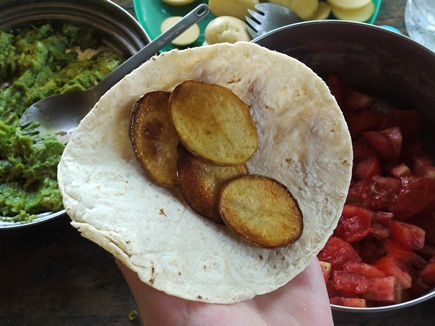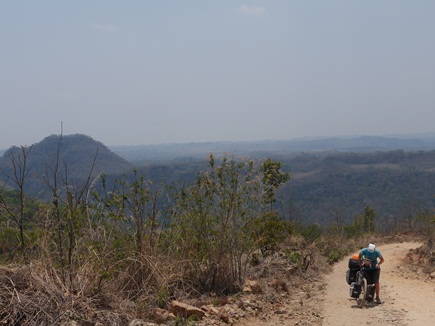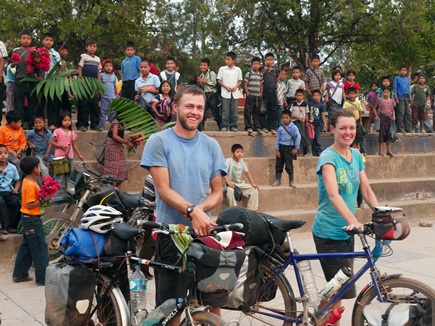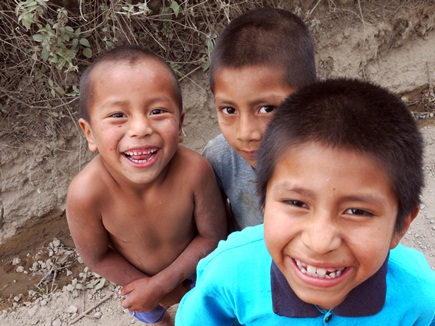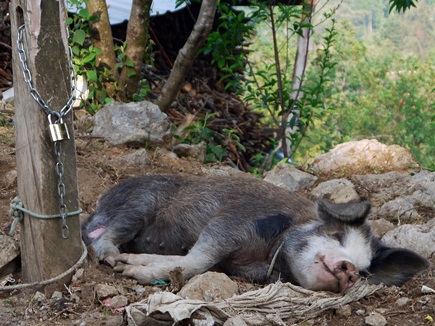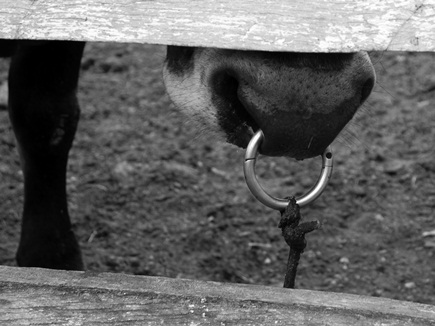Vuelta de Chiapas
May 6th, 2012
When people return from holiday and they’ve had a good time, you always hear them say “…and the people were SO nice!” like this is some sort of surprise or shock. Is it actually a reassuring sign that deep down most people genuinely are good? Mexico has seen us enjoy so many unmotivated, generous acts that it’s difficult to sum them all up.
We’ve experienced the country from a rare perspecitve; by arriving by bike and avoiding the main tourist areas where we can. The Mexican people we have spent time with in these smaller towns and villages have always wanted to know more – about our trip, about our homes and about our impressions of their country. This last topic is always interesting. We’ve been asked more than once “what were your impressions of Mexico BEFORE you came here”. Whilst we chose to ignore them, our time in the US was littered with conversations warning us to expect a country full of murderers and thieves; and with people begging us to reconsider our planned travel there.
The reality we have found is that people go out of their way to help, to welcome and to feed three dirty cyclists who are, let’s face it, basically on a long holiday and don’t deserve such gifts. From Roberto who allowed us to camp at his ranch the second night we were in Mexico, to the lady yesterday in a village pharmacy who filled our bottles of water for free when she was selling bottled water from her fridge, it feels like it has been an endless line of people queueing up to be good to us.
After four months in Mexico and on the verge of entering a new country (Guatemala), we can’t help but reflect on how lucky we’ve been to meet all these wonderful people in a land which according to the worldwide media is so dangerous. But then perhaps it’s not luck but the fact that Mexico is actually just brimming with lovely people – the troubles they have are contained to a minority of the population that makes front page news everywhere else.
We will share our impressions of this country with anyone who will listen: Mexico is fabulous. Go there and see for yourself. The people we have met and the food we have eaten (there’s been some good cycling and attractive scenery along the way too) has enriched us, enlightened us and inspired us to offer the same generosity and hospitality when we get home…if that’s the lasting impact of a “bad” country, we’re pleased we ignored advice, and we look forward already to our return here.
Our last three weeks in Mexico were no exception to the enjoyable experience we’ve had throughout. We finally managed a departure from San Cristóbal after a long month where we’d been trying to flush out unwelcome parasites (oh, there you go, something we didn’t enjoy about our stay in Mexico: unwelcome doses of entamoeba histolyica, giardia and hookworm for each of us!). The trip to the border via a very circuitous route saw us weaving around Chiapas, a beautiful state with wonderful sights.
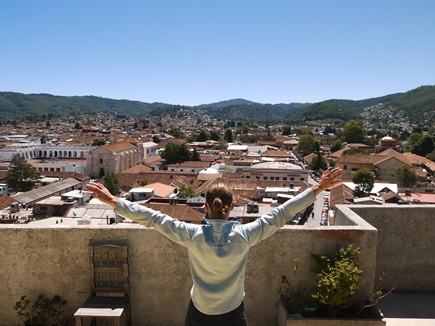
Leaving San Cristóbal after a month was a shock to the system. Despite the parasites, we made the most of our time here, enjoying a free film festival, a live Easter crucifixion re-enactment, meeting a lively group of Mexican language students and soaking up the picturesque settting from our rooftop terrace at Tierras Mayas language school…
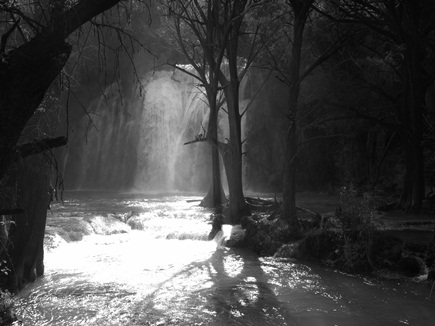
First stop out of San Cristóbal was the stunning waterfalls at El Chiflón. Great to be back on the bikes and back in the countryside.
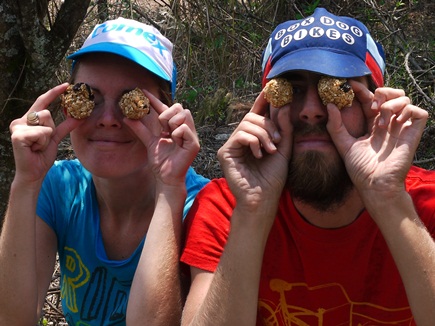
We had time on our hands in San Cristóbal so made a supply of power bites – the ultimate cycling energy food…oats, caramel, raisins, nuts…all squished together into little calorific balls and no need to cook – perfect for the inevitable early morning snack stop.
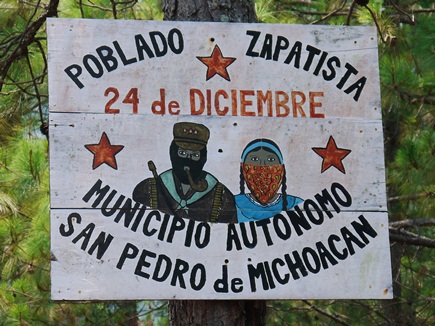
The state of Chiapas is in parts autonomously controlled by the Zapatista Movement, a group of indigenous Mexicans who have been fighing for equal rights and recognition since the 1990s. The Mexican government seems to largely ignore them and they hold control over their own villages in this area. We cycled through many Zapatista controlled villages en route to Laguna Miramar.
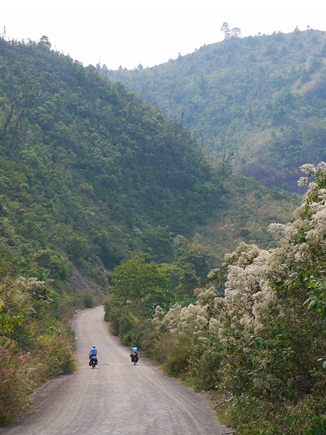
We took a quiet road through the mountains and surprised lots of locals who don't often see tourists, let alone tourists on bikes.
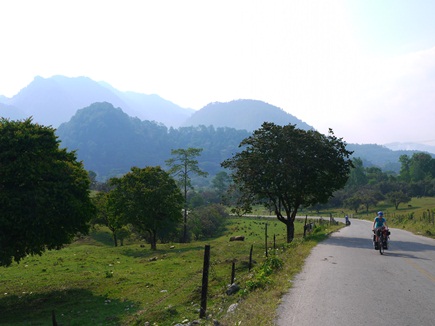
Popping out in alpine valleys such as this one was a surprise to us too. It felt more like we were in a corner of Switzerland than Mexico…quite different from the deserts of Baja that we cycled through, back in November.
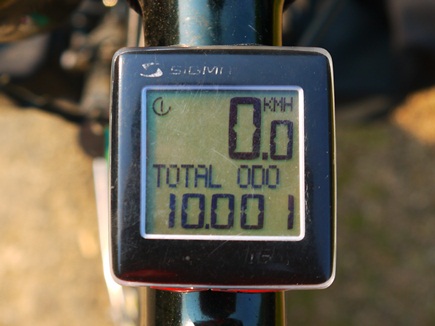
Reaching 10,000km of cycling on our trip so far and a brief pause taken to pinch ourselves a bit and to reflect on the scores of great people we've met, the hundreds of tortillas we've eaten, the thousands of photos we've taken…

…and then back to business; another day, another dirt road. We bumped downhill and then slogged uphill on unforgiving stony paths in baking heat to lead us to Laguna Miramar…

…often it all got too much and grabbing the opportunity to lie down and snooze after lunch was far more preferable than setting off again straight away.
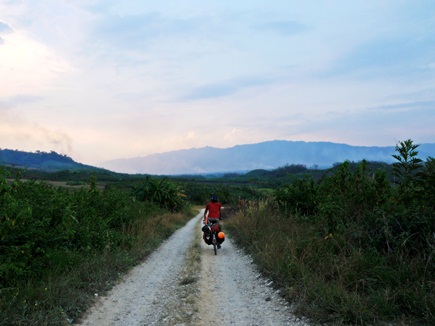
These dirt roads are not to be disrespected either. This photo was taken at nearly 7pm – the sun is sinking and we are still short of our intended overnight stay by 10km. So we ended up stopping in the next village and camping outside a shop.
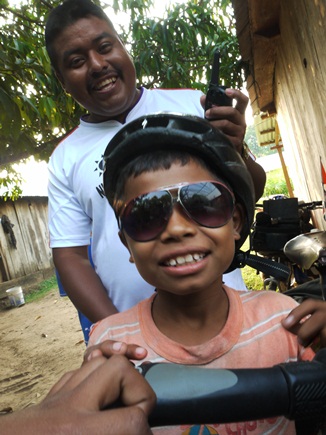
The next morning, the local kids crowded around the bikes, asking questons, prodding parts and trying on James' fetching cycle accessories.
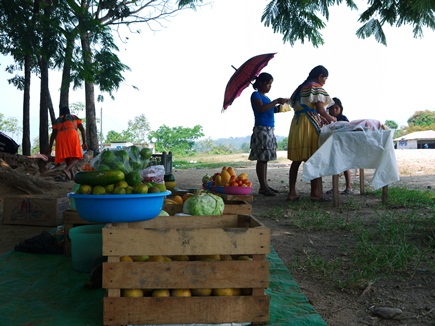
Reaching the last village before heading out to the laguna, we stocked up on fruit and veg at this roadside stall. Sweet mangoes, fresh potatoes, soft avocadoes, ripe tomatoes. Mexico tends to sell just a few types of fruit and veg, but what they sell is very tasty indeed.
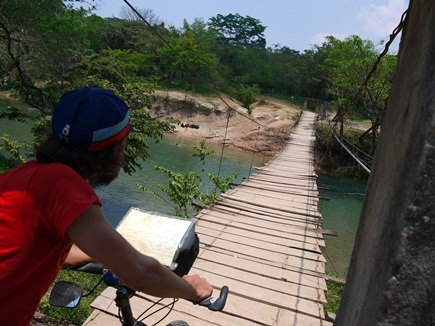
Having paid our fee to enter the park and being reassured by locals that we could take our bikes with us, we set off for Laguna Miramar, one of the most remote and beautiful natural sites in Chiapas. First though, a white knuckle bridge crossing…
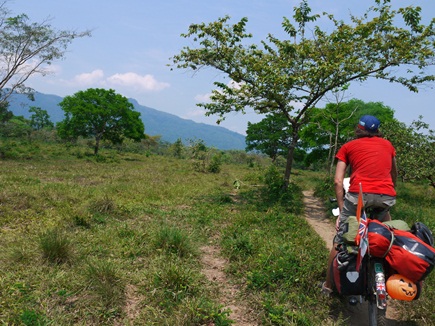
The locals were right, we “could” take our bikes along what was by all accounts a dirt horse track. In parts, it was pretty and the riding was easy…
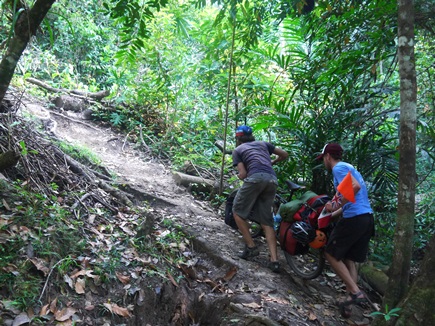
…mostly though it involved pushing, sweating, swearing and crying our way up and down enormous rutted slopes and over thick tree trunks.
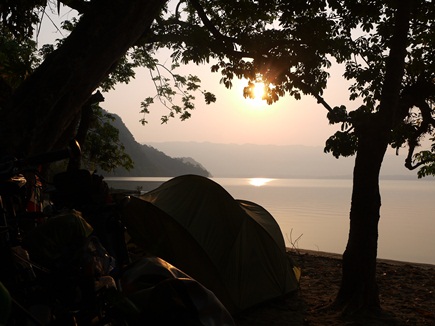
Thankfully the end destinaton proved to be worth the effort. Prime camping spot on the beach at the laguna's edge, where we more or less had the place to ourselves.
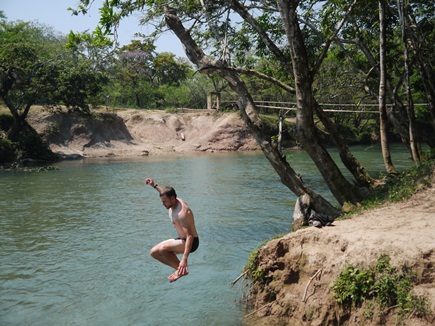
Sweating our way back out to the road was about as much fun as it had been on the way there…but this time we had our priorities right: jump straight in the refreshing river and cool off before doing anything else.
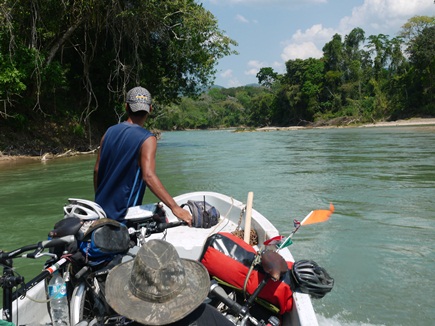
We had two options to leave this remote area. First option: another steep dirt road with possible Zapatista fees to be paid and a less than accurate map of the area. Second option: a lancha boat ride down the river to pick up a more frequently used road and a more direct route to the border. We opted for the lancha and took our bikes for a ride along the river…

A common sight for us in the last few weeks: a local who has spent the morning drinking more than his fair share of booze and passed out in the front of the nearest abandoned building or patch of grass before lunchtime. Unfortunately, sticking out like a sore thumb in these areas, means we attract the attention of most of the local drunks (those who haven't yet got to the passing out stage), leading to many incoherent and baffling conversations.
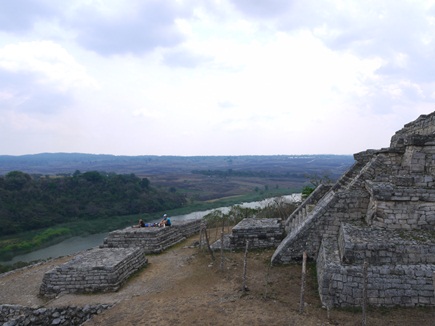
Our final day in Mexico was spent visiting the Mayan ruins at Chinkultic. We soaked up the views and wandered around the impressive remains of a Mayan settlement from over 1000 years ago….and Lee took a short nap at the top.
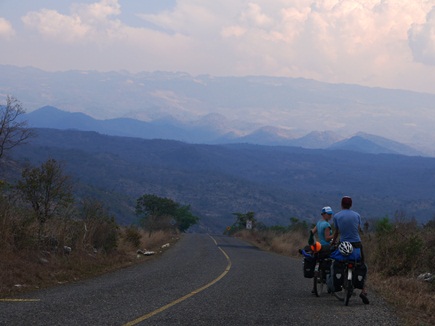
Over the border into Guatemala and we are welcomed by the sight of the Cuchumatanes mountains – the highest range in Central America…the stage is set for more hills and more dirt roads…
Sarah
Mexico: an A-Z
May 20th, 2012

¡Adios! Where we say hi!, Mexicans say bye! – and so calls of ¡adios! followed us wherever we rode in Mexico, shouted cheerily from passing cars, doorways, family gatherings and hidden bystanders in trees and fields of maize. Prize for the most extreme ¡adios! though has to go to this guy, who hailed us from the top of this 50m electricity pylon and brightened up a dull morning crossing the Istmo de Tehauntepec. In true Mexican style, no harnesses or ropes in sight…
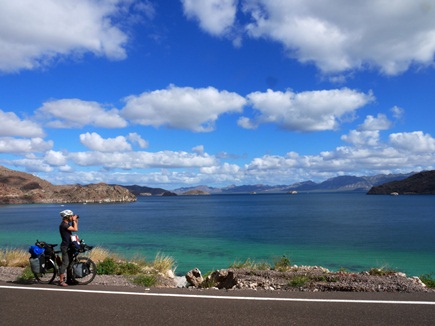
Blues. Turquoise sea meets cobalt sky in the Bahía de la Concepción, Baja California – one of the most stunning sections of Mexican coastline we rode.

Coco's Corner. Old toilets clustered around a disconnected TV set, a ceiling hung with female visitors' lingerie, and a Mexican amputee racing around on a kids' quad bike. Coco's Corner, a bizarre hideout in the middle of the Baja desert, was definitely our most surreal but also one of our best overnight stays in Mexico.
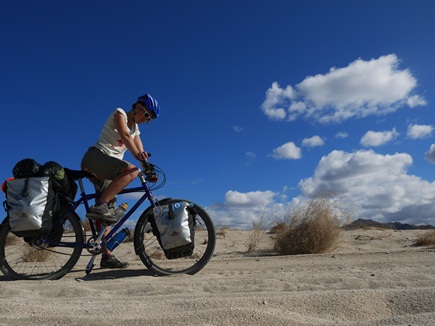
Dirt Roads. “Good roads, bad people; bad roads, good people”. So said Baja Barney, who proved his own point by putting us up in his absent neighbours' beachfront condo at Gonzaga Bay, Baja Norte. This 60km stretch of dirt road and sand south of Puerticitos was my favourite ride in Mexico; here, away from the truck-dodging on Highway 1, Baja really came alive with deserted coastline and untouched desert.
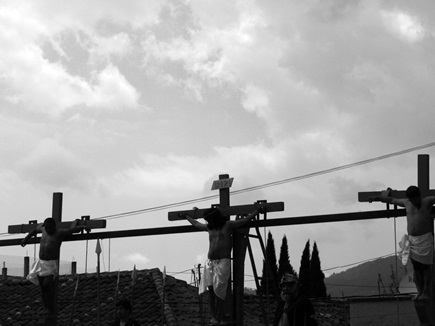
Easter. This year we swapped Easter Eggs for a live re-enactment of the Easter story through the streets of San Cristóbal de las Casas, culminating in a dramatic crucifixion under stormy skies outside the church in Barrio de los Méxicanos. I still missed my Kit Kat chunky egg though…
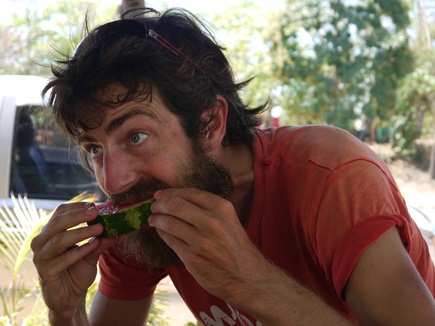
Frutas. Inspired by Lee, our very own Man from Del Monte, we got stuck into Mexico's incredible array of fruit. Fresh sandía has never tasted so good as at this roadside stop on the Oaxacan Coast in 40 degree heat. I'm just not sure how we will ever go back to bland, long-life supermarket fruit after this…
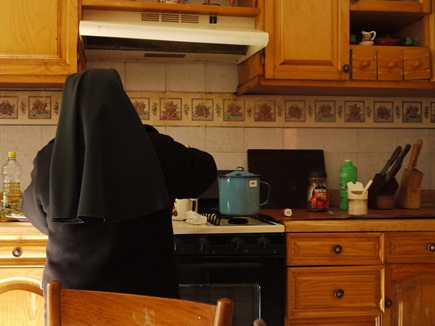
Guerrero. After this stay with the monjitas in Vicente Guerrero, I can now add “nunnery” to my list of overnight stops. Things got even better when the Madre insisted on making us coffee, eggs and frijoles to set us on our way the next morning.

Hostalito. Finally, a hostel with some character and charm. Run by Joaquin, a Pan-American cyclist who got stuck in San Cristóbal, El Hostalito was definitely the coolest place we paid to stay at in Mexico. Real beds, a proper kitchen and a great DVD collection – everything a tent-bound cyclist craving some home comforts needs for a few nights!
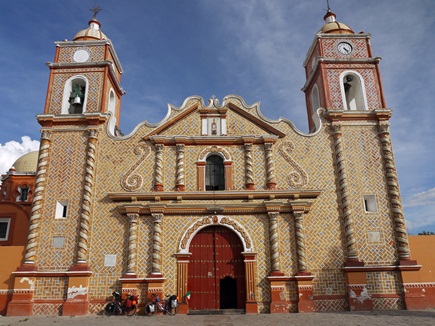
Iglesias. In an effort to prove just how godly and important they were, the Spanish conquistadores left Mexico with an incredible array of churches. Even the smallest of pueblos we rode through, like this one as we left Puebla, often had an elaborate church fronting onto its central square.

Juncalito. One night became two, and then three at Playa Juncalito, south of Loreto in Baja Sur. We even left one morning and got 10km up the road, before deciding we needed just one more night and turning around again. There was nothing to do but read, doze, watch the Ospreys fish, and feast on our own delicious dorado donated by friendly neighbours.

Kayaking. It doesn't get much better than kayaking at dawn in the Bahía de la Concepción, Baja Sur. An enormous thank you to Fabian, our Warm Showers host who amazingly opened up the home he had rented for his family holiday to four hungry and dirty cyclists.
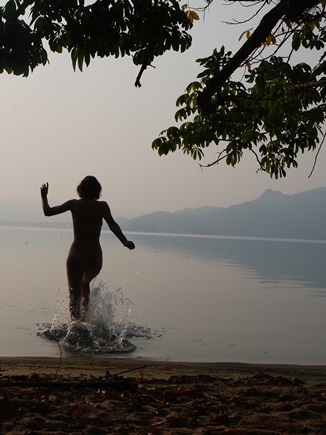
Laguna Miramar. In my ideal world, every morning would start with a swim in a lake, river or the sea. We managed a lot of early morning dips in Mexico – but few better than this one at Laguna Miramar, where even Bedders was tempted straight from the sleeping bag into the bathtub-warm water.
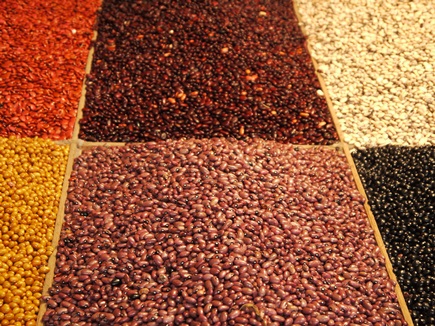
Mercados. If you still need convincing that supermarkets are A Bad Thing, then you should visit a Mexican market. Riots of colour, smells, and noise, Mexican markets put fun and social interaction back into our daily shopping, and came as a breath of fresh air after the sterility of the Western shopping experience.

Navidad. We might not have had a chimney, but we made up for it with beards, santa hats and roast chicken for Christmas in La Paz, Baja Sur.
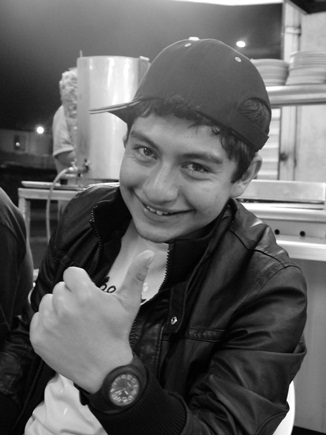
!Órale güey! (“Right on dude!”) With the rest of our trip in the Spanish-speaking world, it's been great to re-immerse myself in Latin American culture and language. Brushing up on our Mexican street slang with the help of Ares in Puebla and students in San Cristóbal has been a highlight.
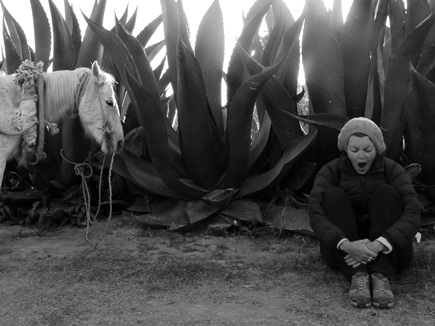
Pueblitos. Sarah shares a bleary eyed dawn moment with a pony in Oxaltepec, Puebla as we help Dionisius to harvest the agua de miel (honey water) from the magüey cactus. The real charm of Mexico for us has been in these moments in just some of the tens of tiny pueblitos (villages) we have ridden through each day. It's easy for us to romanticise what is a tough existence, but there is an undeniable appeal in the simplicity, generosity and sense of community we found here.

Quesillo. One of the things we've missed most since we left home has been our beloved cheese. Stringy Mexican quesillo isn't exactly strong on flavour, but served in a cemita like this with milanesa (crispy breaded pork), avocado, tomato and jalapenos, it's hard to beat. I have to admit we stayed an extra day in Puebla just to try this local market speciality – and it was well worth it.

Rancho el Tejón. Wherever we have gone in Mexico, we have been bowled over by people's warmth and generosity. One of our first experiences of Mexican hospitality was with Cristina at Rancho el Tejón in Baja Norte. We stopped by to deliver a package from the infamous Coco, and Cristina immediately invited in to stay the night – before sending us on our way with a huge slab of chocolate cheesecake the next morning. These are the moments that put grins on cyclists' faces.
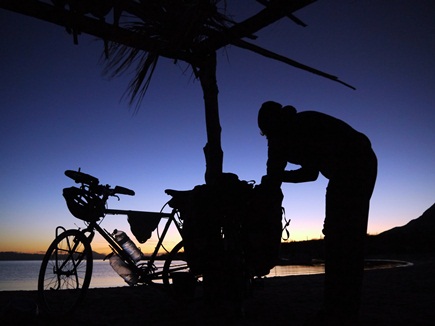
Sunrises and sunsets. Baja California does sunrises and sunsets like nowhere else I've been. This was the view from Playa Réqueson, where we unrolled our mats and sleeping bags for the night under a palm palapa.
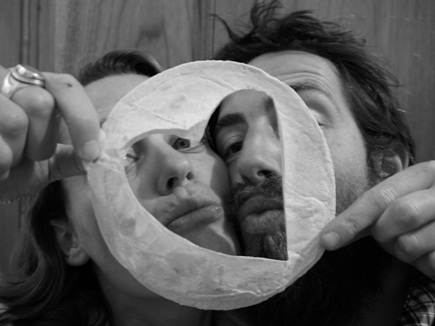
Tortillas. Flour, corn, blue, machine pressed, hand patted, large and small – our daily tortillas changed as we moved south through Mexico, but they remained at the centre of Mexican food we loved. Stuff them with carne asada, pastor, adobado or fish and you have mouth watering tacos; fold them over and fill them with chicken and cheese and you have empanadas; fry them and spread them with frijoles, avocado and cheese and you have crunchy tostadas; stretch to pizza size and add toppings and you have tlayudas. Tortillas will be with us for many more miles to come, but maybe never again in such glorious variety…
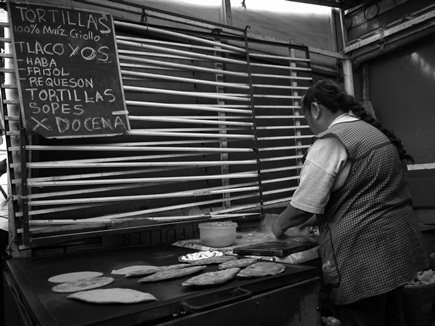
Ubiquitous. Wherever you find tortillas, you'll find the comal – a simple but ingenious hot plate over a gas flame at the heart of Mexican cooking. In Amecameca, we feasted on Tlacoyos, folded blue tortillas stuffed with frijoles and white beans and toasted on the hot comal. Whenever we next find ourselves with a kitchen to call our own, a comal will definitely be first on the shopping list.
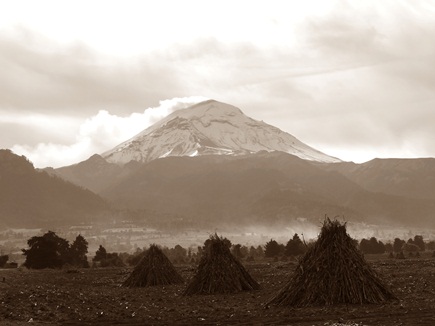
Volcán Popo. Mainland Mexico has forced us to rediscover our climbing legs – and we were straight in at the deep end when we left Mexico City and climbed between the two sleeping giants of the Popo and Ixta volcanoes. Except Popo isn't quite asleep – the rumblings and ash clouds we saw as we rode through were just the precursor to much more dramatic recent activity, which has seen the area closed off.

Waking Up. I normally find waking up a traumatic process at the best of times, but dragging yourself out of your sleeping bag certainly becomes a lot easier when you open your eyes to morning views like this. Another spectacular sunrise at Bahía de la Concepción, Baja Sur.

Extra Curricular activities (OK, I struggled with X). In between the cycling, and certainly when the parasites invaded in the second half of our time in Mexico, we found plenty of time to indulge in reading. Or at least Lee did until he tragically knelt on his Kindle – at which point he took up knitting instead. No wonder we get so many stares.

“Yo soy de los EEUU” (“I'm from the USA”). Mexico wouldn't have been half as much fun without Lee. Despite his constant struggles with the English language (let alone the Spanish), our shared passions for tacos, beards, Fritos, more tacos, being easily distracted, and – just sometimes – cycling very slowly, made him our perfect third wheel.
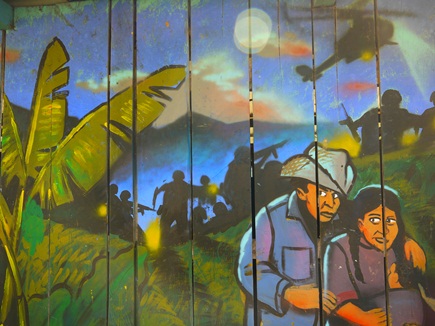
Zapatistas. Our final Mexican leg took us into the jungles of Chiapas and Zapatista territory, where in the mid-90s the Mexican government waged war against an indigenous uprising. Even here, Mexican hospitality ruled supreme – proof perhaps that despite the enormous political and social problems that the country faces, the indomitable Mexican spirit and warmth that we have experienced will help to preserve the uniqueness of this fascinating and varied country.
James
Hitting the wall
May 24th, 2012
We sat at the side of the road, bikes thrown down in disgust, and glared at each other. Silently we blamed one another for our situation – but the real cause was another brutal, seemingly vertical stretch of Guatemalan climb which lay between us. Tears were rolling down her cheeks, and after three days of slog, I knew that there was no way we would be climbing any more. In silence we turned round and rolled back down the valley to the town of Todos Santos and a waiting bus, covering in five minutes a distance that had just taken us two hours to climb.
To any non-cyclist, I can imagine this sounds incredibly melodramatic. If a hill is too steep to cycle up, then of course you just get a bus. What’s the big problem? Who cares? No-one of course. Except that we did care – because for the first time in 10 months and 10,000km, we’d had to admit that we couldn’t actually cycle this road.
Of course, we’d “cheated” before – like skipping most of Canada on a long ferry ride, or taking a boat out from Laguna Miramar just a few weeks earlier in Mexico. But on those occasions we had deliberately chosen not to ride in exchange for another experience. This was different. In the ongoing battle of touring cyclist versus road, for the first time the road had won. And to a pair of stubborn cyclists who thought they could ride up anything, that was a hard thing to swallow.
I guess I knew that eventually we would find our limit – but I had thought it might be in the mighty Peruvian or Bolivian Andes, rather than here in the little-known Cuchumatanes of northern Guatemala. At least then, there would have been some element of honour and glory in defeat – I mean, who would try to cycle through the Andes anyway? But I had underestimated just how steep this wall of mountains that welcomed us to Guatemala were.
Of course, as usual we hadn’t helped ourselves. In our constant (and to everyone else, probably rather tedious) quest to ride the road less travelled, we had avoided the main route from Mexico into Guatemala with its smooth tarmac and well graded hills. Instead we chose a circuitous back door route which our map classified as “seasonal track” and in reality meant three days of sweating, swearing and a lot of back-breaking pushing.
We sat in disconsolate silence as the bus crawled its way back up the hill past the point where we had turned back, our bikes expertly lashed to the roof alongside sacks of maize and half a dozen chickens. There was no pleasure in the cheat; no satisfaction in avoiding the sweat and toil of crawling our way up the hill. Both of us would have given anything to have been out there riding. For once, I concluded, the plan had backfired. We weren’t really the globe-trotting, off-road “adventure” cyclists we had hoped we might be.
But the more I thought about it, the more I realised it really hadn’t backfired. Firstly because no-one really did care if we had taken a bus or not. On that front, we just needed to swallow our pride and take ourselves a little less seriously. But mainly because if we hadn’t attempted the route we had just ridden in the first place, then we would have missed three days of incredible experiences amongst the sweat and tears : a river crossing without a bridge, a night camped in a municipal hall with an audience of schoolchildren, and a village football match with locals in their traditional dress.
It sounds like a terrible cliché from a motivational speech – but I realised that the real failure would be to take this experience to heart, and to stifle our curiosity for the roads less travelled. It would be easy to start choosing the obvious path, the nicely tarmaced but traffic-choked and monotonous roads we try to avoid. But we would have many more regrets.
Instead we should stick with our approach of seeking out more interesting and challenging routes – but just with a touch more pragmatism thrown in. Like choosing tracks that we can at least occasionally ride on, rather than footpaths that leave us pushing for hours. And if we have to take a few more buses, then who cares? At least we will always know that our experience will have been be so much richer for trying.
James
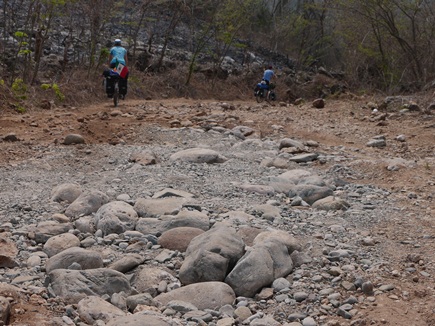
After an easy downhill coast from the Mexican border to Nentón, we had two options to take us up into the Todos Santos valley: a round-about tarmac route, or an intriguing dirt road “shortcut” from Nueva Catarina to San Andrés Huista. We deployed our usual tactic of taking a straw poll of three locals; one said the dirt road was rideable, two said we had no chance. Needless to say, we chose the dirt option…
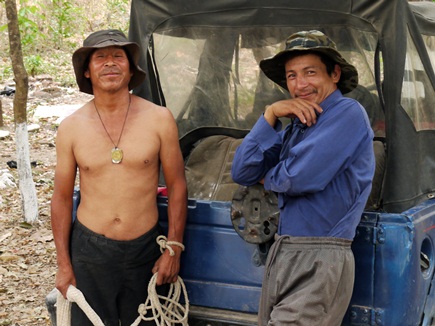
Fairly soon we faced our first challenge – the bridge across the river at Vieja Catarina had collapsed years ago. Fortunately, these two friendly fishermen were on hand to help us find the best crossing point…
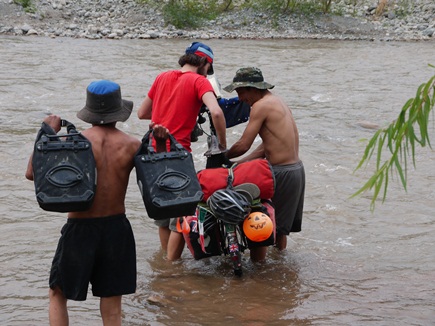
…and to help us wade across. A few weeks later and with the onset of the rainy season, we might have been swimming.
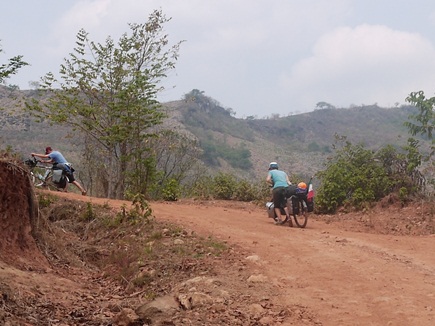
Our fishermen friends assured us that the road ahead was rideable – but within minutes we were off and pushing. Loose earth, a 20% gradient and fully loaded touring bikes do not mix well.
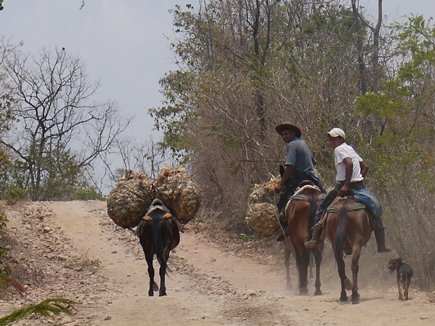
…much to the bemusement of locals, who far more sensibly opted for horse-powered transport to collect their firewood.
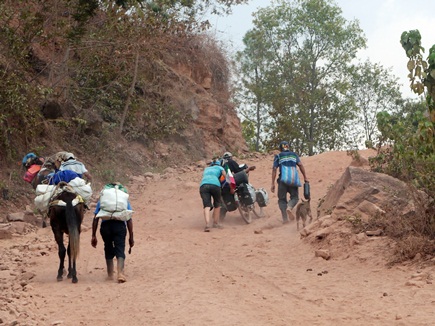
After five hours of back-breaking pushing, eventually we reached the outskirts of San Andrés – where some villagers took pity on Bedders to give her a running push up the final hill.
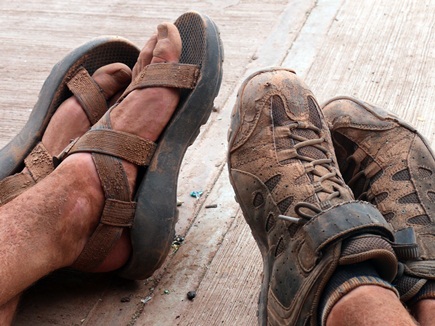
There was no way we were going any further that day, and so we collapsed in a dusty heap and attempted to revive ourselves with coke and chips from the ever-present Guatemalan fried chicken stall.
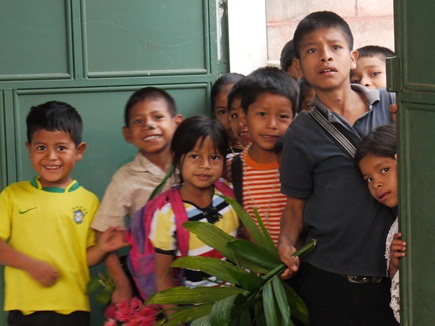
After introducing ourselves at the mayor's office, we were given permission to camp in the village hall – a covered space enclosed with metal bars which we quickly christened the Gringo Zoo. We woke in the morning to the entire population of the nearby primary school peering through the bars at the strange visitors…

Their teacher explained that most of the kids would only ever have seen “people like us” on TV – which explained their fascination with us, our bikes and especially with our cameras.
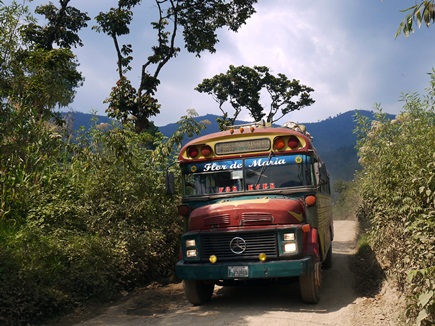
Over the next two days we continued to climb slowly up through the beautiful valley towards Todos Santos – dodging chicken buses coming the other way…
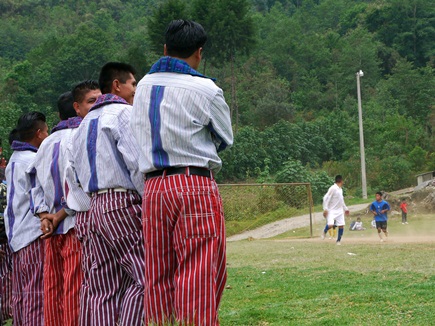
Stopping to watch a village football match gave us the chance to admire what must be the coolest traditional dress going – striped pyjama-style trousers and a high collared shirt…
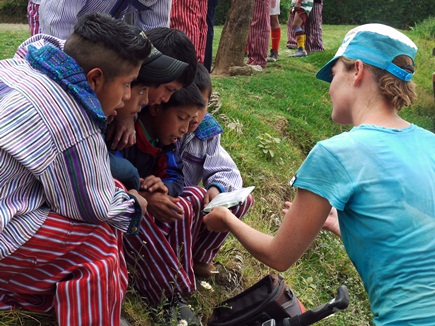
…while the locals were equally intrigued to see where they lived on our map, and find out where the weird gringos on bikes had come from.
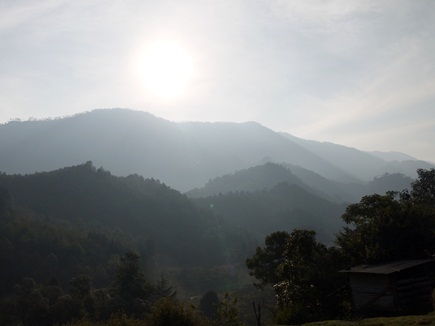
After being invited to camp in his half finished house by Jovel, a friendly local, we headed on up towards Todos Santos in the early morning light…
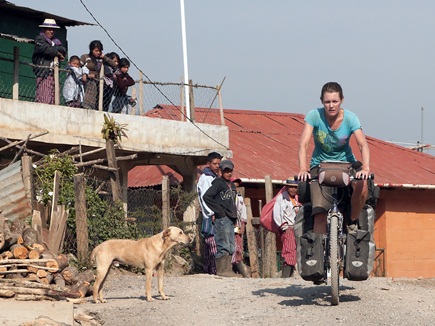
…and more curious bystanders. After lunch in Todos Santos, we set out on the climb that would eventually defeat us and have us coasting back down the mountain in search of an escape by bus.
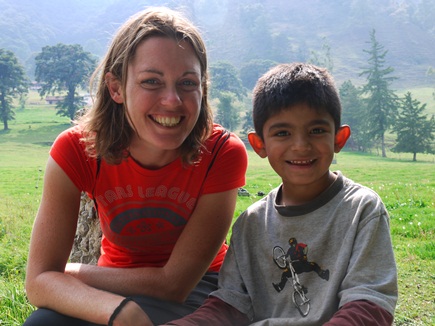
After a night in Chiantla, Lee set off directly for Xela, while we headed east towards Nebaj. Here we abandoned the bikes to walk through the mountains to the beautiful village of Acul, set in a deep valley and surrounded by lush Alpine scenery. We'd heard rumours of a local farm producing swiss-style cheese, and so we set off with our guide Carlitos to successfully satisfy our craving…
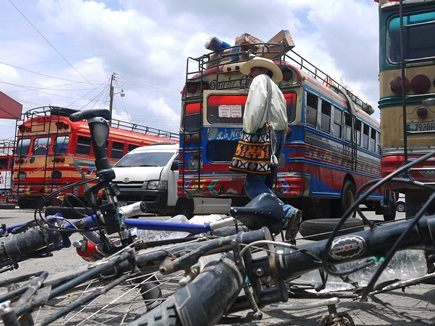
Our plan had been to spend the next couple of days riding to Xela via Santa Cruz del Quiché, but once again things didn't quite go to plan. The hideous sulphurous odours emanating from my every orifice told me that my giardia was back with a vengeance, and reluctantly we were once again forced to pile our bikes and belongings back onto a bus, and take the easy option out.
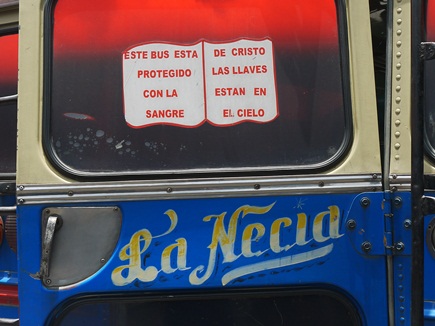
And so we headed for Xela, where we planned to spend the next few weeks in language school brushing up on our Spanish grammar. At least we were assured of a safe ride there on our chosen bus: “This bus is protected with the blood of Christ – the keys are in heaven”.
